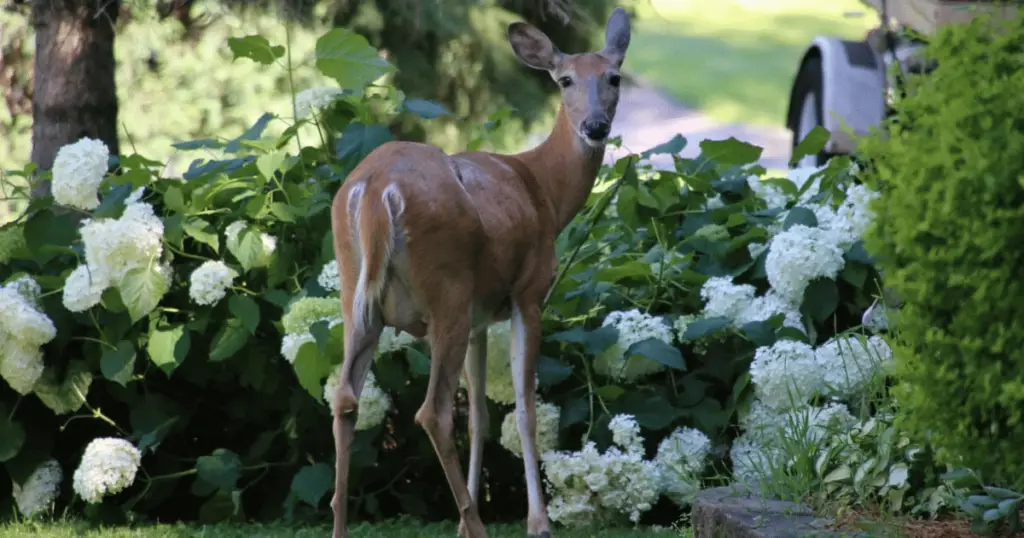Last Updated on July 26, 2023 By Emma W. Thomas
Yes, deer eat hydrangeas. To protect these plants, consider these measures:
- Install deer fencing or netting around the plants
- Use deer repellents or sprays with strong odors
- Plant deer-resistant varieties
- Create physical barriers like thorny bushes around hydrangeas
- Scare deer away with motion-activated devices or radios
Are hydrangeas deer-resistant? Let’s rate hydrangea types for deer-resistance

When planning the ideal flower garden setting, balancing practicality and aesthetics is essential. Thus, if the residence is in a region with a high deer population, the resistance of plants to deer becomes a significant consideration. One common plant popular among both landscaping artists and homeowners alike is the hydrangea. But, the question that arises is:’Are hydrangeas deer-resistant?’
1. Bigleaf Hydrangeas (Hydrangea macrophylla)
This hydrangea type is perhaps the most common hydrangea species. There are numerous varieties, each with unique charm but with limited deer resistance. Bigleaf hydrangeas are known to be munched on by deer.
Deer-Resistance Rating: 2/5
2. Oakleaf Hydrangeas (Hydrangea quercifolia)
Named after its beautiful leaves, similar to those of an oak tree, this hydrangea is a solid choice when considering deer resistance. While no plant is entirely deer-resistant, Oakleaf Hydrangeas are less likely to be damaged.
Deer-Resistance Rating: 4/5
3. Smooth Hydrangeas (Hydrangea arborescens)
This species is native to the east coast of the United States and is commonly known as the ‘wild hydrangea’. It too lacks substantial deer-resistance as it can be an enticing snack for deer.
Deer-Resistance Rating: 2/5
4. Panicle Hydrangeas (Hydrangea paniculata)
Renowned for their cone-shaped flower clusters, Panicle Hydrangeas hold up somewhat better against deer. This plant makes for a wise choice, with its relatively higher resistance compared to some other hydrangea types.
Deer-Resistance Rating: 3.5/5
5. Climbing Hydrangeas (Hydrangea petiolaris)
As fascinating climbing species, these hydrangeas have a vining habit and can be made to grow against a wall or a fence. Unfortunately, their appeal reaches not only humans but deer as well, offering limited resistance.
Deer-Resistance Rating: 2.5/5
How To Prevent Deer From Feeding On Your Hydrangeas
Nothing disappoints like waking up one day to find that deer have damaged your favorite hydrangea bush. But, the good thing is that you can learn how to stop these herbivores from feeding on your plants. The techniques to use include;
Planting The Right Variety
To protect your hydrangea from damage from deer, you can choose a species that is not attractive to them. For example, oakleaf hydrangea does not attract deer, and it produces white flowers. You can opt for dwarf or full-grown plants. You can also go for climbing hydrangeas since they can grow up to several dozen tall, making them out of reach for the deer.
Use Of Deer Repellent Concoction
You can repel the deer from your hydrangeas by using a simple homemade recipe. You will need
- One liter of water
- An egg York
- One teaspoon baking soda
- A spray bottle
Mix the above ingredients properly and place the mixture in a spray bottle. You can choose a spray bottle with large holes to prevent the mixture from sticking. Spray your plants every fortnight or after the rains. This solution effectively keeps away deer, and it is also effective in all weather conditions, especially when it is hot and sunny.
Since the recipe is chemical-free, it is safe for your plants, deer, and other animals. The deer will not like the egg’s smell, and they will seek other sources of food instead.
Use Of Scented Soap
While this may sound old school, you can hang your favorite scented or deodorant soaps on plants near your hydrangea. Doing this will deter the deer from coming near or eating your plants since the animals hate the strong smell of soap.
Avoid Plants That Attract Deer
Plants such as tulips, lilies, pansies, apples, cherry trees, knockout roses, and arborvitae are attractions for deer. Be sure to avoid planting them near your hydrangea plants to deter the deer. You can instead plant spirea, lavender, boxwoods, and daffodils, as this will surely keep the deer at bay.
Covering Your Hydrangea In Deer Netting
You can also buy deer netting from your local home stores or online such as from Amazon. These items are effective in covering your hydrangea plants to keep them safe from deer. This netting is almost invisible and lightweight, and you can anchor it on the ground using wooden stakes and drape it on the bush.
Since the hydrangea will grow through the netting, you will need to remove it carefully not to spoil your plants. It would help if you were more careful during the fall when the plants shed their leaves and flowers.
Using An Electric Fence
You may also think of investing in an electric fence if you have several hydrangea plants. Doing this will help to keep off the animals and allow you to enjoy your blooms peacefully.
Keeping A Radio At Night Near The Plants
While this may sound far-fetched if not funny, you can place a radio on your bush at night. You can use a solar-powered device to make it easy and cheap and occasionally change the station. The noise from the radio will help to scare the deer away.
Which Deer-Resistant Shrubs Are Great For Landscaping?
While the deer will eat almost any plant when hungry, some deer-resistant shrubs are great for landscaping. Even if the deer munch on these shrubs, the damage is minor, and the plants can still recover.
Here are some shrubs that the deer is not likely to eat;
Boxwood (Buxus)
Boxwood is an evergreen plant with broad leaves like deciduous plants. Since they keep their leaves in the winter, shrubs are a popular choice for hedges. It is very easy to maintain the plants since you only need to prune them annually to remove unhealthy parts and maintain their shape.
These plants are not attractive to deer since they contain alkaloids that the animals dislike.
Bluebeard (Caryopteris)
Bluebeard (Caryopteris) is also known as the blue mist shrub. This plant blossoms in late summer when very few plants are flowering. It is tolerant of drought and a favorite of various pollinators. Although butterflies and bees like Bluebeard’s flowers, the plant has a strong scent that repels the deer.
You can maintain the plant’s shape and flowering by cutting its back in the spring by half. You may also need to prune any dead and unhealthy parts when the need arises.
Andromeda ( Pieris Japonica)
Andromeda is a dense flowering shrub that is also resistant to deer. This plant looks beautiful in the early spring, although it is evergreen. During this season, its showy flowers bloom, producing a powerful aroma that keeps off dear, preventing them from feeding on it.
While you need to protect the shrub from cold winter winds, it is a low-maintenance plant that requires only pruning to retain its shape.
Butterfly Bush (Buddleia Davidii)
While butterfly bush is seen as invasive in most regions, it can be an excellent choice for landscaping. Some of its varieties, such as blue-chip, are seedless or have fewer seeds making them unable to spread. The name butterfly bush is because they attract pollinators, but deer avoid munching on them.
These plants do not need a lot of care, and pruning is optional. You can prune them to keep the bush compact and have more prolific flowers. If you love to give your landscape a neat appearance, you can trim the stems down near winter.
Bayberry (Myrica Pensylvanica)
These plants are native to North America and are a good example of deer-resistant plants. While it is more commonly found in the wild than in people’s compounds, it has a fragrance that discourages deer from eating. This plant is tolerant to erosion, salt, and drought and thus low maintenance. But, if you don’t want them to spread, you may have to remove suckers.
Shrub roses (Rosa sp.)
Shrub roses have thorny stems making them a good option in places where deer are an issue. The most favorite variety is candy oh since it has a beautiful fragrance and vibrant coloring. This plant produces beautiful flowers during summer, thus attracting many pollinators.
To maintain their beauty, you can prune the roses in early spring before they start flowering. You can also remove the diseased, overgrown, or dead wood to enhance an excellent airflow to prevent diseases and pests.
Will Hydrangea Grow Back If Deer Eat Them?

Yes. Your hydrangea will bloom back since the deer only eats the top. Hydrangeas have flower buds that act as a backup when eaten by the deer. If the buds remain after the deer damage, the shrub will still flower again.
Conclusion
Since deer feed on almost everything when hungry, they won’t spare your hydrangea. It is necessary to put all precautions to protect this plant from damage by planting other deer-resistant shrubs near them. You can also apply other methods that help to deter the animals, such as erecting an electric fence and other suitable methods as mentioned above.
References:
https://savvygardening.com/are-hydrangeas-deer-resistant/
https://www.conserve-energy-future.com/do-deer-eat-hydrangeas.php
Emma is a graduate of Domestic Science or Family and Consumer Sciences (Home Economics) from the University of Wisconsin. She has 7 years of experience Working with the strategic section of BestBuy and now writing full-time for Homeeon.
From Managing the Home, Interiors, Cleaning, and Exteriors to Gardening and everything about Making A Home Liveable – is her passion and this Homeeon is the result of this.
Emma loves decorating her home with the best stuff found online. She cares about quality over anything and writes reviews about them here in Homeeon. Get in touch with her over Pinterest.
Keep reading her blogs.

